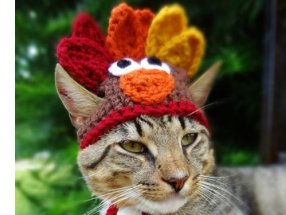|
|
|
Reasons to “Paws” and Be Thankful: Thanksgiving and Pets
|
| TOP 10 REASONS TO GIVE THANKS TO YOUR PET THIS SEASON:
|
| Regardless of why we have pets in our life, the simple act of their being there brings a certain peace to many pet  owners. The unconditional love and companionship pets give us, not to mention the time spent playing and relaxing together, is precious to both people and pets alike. Here are our top 10 reasons to give thanks to your pet this holiday season: owners. The unconditional love and companionship pets give us, not to mention the time spent playing and relaxing together, is precious to both people and pets alike. Here are our top 10 reasons to give thanks to your pet this holiday season:
- Pets bring us joy. Despite their sometimes-bad habits, the crazy antics and strange wild playfulness of our pets, they are hard to resist and usually leave us smiling, if not laughing out loud.
- Pets are always happy to welcome us home and give us someone to come home to.
- Pets motivate us to get some fresh air and exercise. Whether it’s taking your dog for a walk or trying to coax your cat off the roof, pets help us get outside and get moving.
- Pets remind us when it’s time to stop working, more often than not by laying on our keyboards, or pouncing on our paperwork.
- Pets love us unconditionally, even when we might not love ourselves that much.
- Pets force us to get up in the morning, whether we want to or not.
- Pets help to protect our homes. Even the smallest dog can deter a stranger, as can many cats.
- Pets give us a chance to meet new people. It’s hard to take your dog for a walk without stopping to chat with someone who wants to say “hi.” This is doubly true if you’re taking your cat on an outing.
- Pets often know when we need a little extra love, and give it without hesitation or having to be asked.
- Pets give us a little extra warmth on a cold winter’s night. Why turn up the heat when you can curl up with your pet?
Whatever your reasons for being thankful for your pet this Thanksgiving, we hope that you will take the time to let them know just how much you appreciate all the good they bring to your life. From the staff at Largo Veterinary Hospital, we wish you and yours a safe and happy Thanksgiving.
|
|
|
|
|
Pet Diabetes is a serious condition.Pet owners should be aware of the possible warning signs of pet diabetes and see Dr. Daniels for a definitive diagnosis. Considering the fact that pet diabetes can be effectively managed, lack of owner awareness may be the biggest risk factor associated with this condition.
Risk factors for diabetes in dogs and cats include advanced age, genetic predisposition, breed, and obesity. That last factor, pet obesity, is on the rise here in the U.S., with over half of dogs and nearly 60 percent of cats falling in the overweight or obese category. As a result, the number of pets diagnosed with diabetes has skyrocketed in recent years.
There is an important distinction to make between canine and feline diabetes. Dogs are usually diagnosed with Type I diabetes because there is a deficiency in the way the pancreas produces insulin. Cats, on the other hand, usually have Type II diabetes that results from a decreased sensitivity to insulin.
Only Dr. Daniels can officially confirm a diabetes diagnosis in your dog or cat. If you suspect your pet may have diabetes, make an appointment for Dr. Daniels to exam your pet as soon as possible. Should she diagnose your pet with diabetes, don’t fret we will make sure you are well-informed and as confident as possible in your ability to help your furry loved one manage his or her disease before you leave the office.
While there is no cure for pet diabetes, there are ways to successfully manage the disease.
|
|
 |
Symptoms of Diabetes Include:
|
- Increased urination and increased thirst.
- Increased appetite. Your pet might grow hungrier over time because the amino acids and glucose needed inside the cells aren’t getting there, or aren’t being used appropriately.
- Weight loss. Despite being hungrier, the energy from food is not being used efficiently by the body’s cells, your pet can lose weight even though he’s taking in more calories.
- Lack of energy and increased need for sleep.
- Vision problems.
- Weakness in rear limbs (cats only). This symptom is unique to kitties with diabetes. Instead of walking high up on the pads of his feet, which is how cats normally walk, a cat with diabetes will drop his hind quarters low and actually walk on his back ankles.
- Urinary tract infections. It’s not at all uncommon for diabetic dogs and cats to acquire secondary urinary tract infections.
- Kidney failure. Kidney failure, especially in cats, is also a common secondary symptom of diabetes.
|
|
 |
|
| | Cats
Cats diagnosed with feline diabetes typically have a normal life expectancy — as long as their owners help them maintain a proper diet, a healthy lifestyle, and check their blood glucose levels as directed by Dr. Daniels, cats with diabetes usually live just as long as cats without.
Dogs
Diabetic dogs once faced a much shorter life expectancy than their healthy counterparts, living on average only 2 to 5 years after their diabetes diagnosis, things are turning around for canines living with this disease. As long as the dog’s blood glucose concentration is closely managed by a responsible owner, and as long as that diabetic dog does not develop any other health complications, dogs with canine diabetes can often expect to live just as long as dogs without the condition.
|
|
|
|
| to your account when you refer a friend and they bring their pet in for their first appointment to Largo Veterinary Hospital.
|
|
|
|
|
|
 Hi, my name is “Scruffy”, and I am a 5 year old female Yorkshire Terrier mix. I was blessed to be adopted by the most wonderful parents in the world. I get to take my family on walks around the neighborhood twice a day. I do this to make sure they are fit enough to care for all my needs. I am not saying I am spoiled, but I pretty much control where I get to sleep on the bed at night and even tricked them into slipping me a little ice cream every night (Psst...don't tell the doctor). Every now and then something would "accidentally" fall off the plate and just happen to land right in front of me!!! I am very honored to have been chosen as the pet of the month for November. My only regret is that I didn't know 4 days sooner because that's when I lost my daddy and I know he would have been very proud of me! I love you, Dad! Hi, my name is “Scruffy”, and I am a 5 year old female Yorkshire Terrier mix. I was blessed to be adopted by the most wonderful parents in the world. I get to take my family on walks around the neighborhood twice a day. I do this to make sure they are fit enough to care for all my needs. I am not saying I am spoiled, but I pretty much control where I get to sleep on the bed at night and even tricked them into slipping me a little ice cream every night (Psst...don't tell the doctor). Every now and then something would "accidentally" fall off the plate and just happen to land right in front of me!!! I am very honored to have been chosen as the pet of the month for November. My only regret is that I didn't know 4 days sooner because that's when I lost my daddy and I know he would have been very proud of me! I love you, Dad!
|
|
 |
Tricks to Avoid Chasing a Loose Pup
Chances are you've unfortunately had the chance to chase a dog that has "escaped" from your loving home, car or lease. For whatever reason it is instinctual to chase a running dog. They run, you run. There's no use in wondering why our dogs run. Even the most active, well behaved, and indulged pets will occasionally take the opportunity to bolt. Instead of chasing your mischievous pup try these tricks next time:
Stop, drop and lie down or curl into a ball You'll look silly that's for sure but your dog will find this behavior odd and make him curious. When you don’t give in and chase but instead lie still and/or curl up dogs will often come back to see what you are doing. You also look like less of a threat than you do chasing and screaming down the block!
Run in the opposite direction Run away from the dog? Yes, playfully call his name and then run the opposite direction. Some dogs just love a good chase with their favorite humans.
Offer and toss treats If you have good treats, place a few around you to draw them near. And sit and calmly as your dog draws near you.
Open a car door and ask the dog if she wants to go for a ride – It almost seems too simplistic and silly to be true, but many a dog has been fooled into hopping into a car because they were invited to go for a ride. It makes sense, especially if the dog has learned to associate the car with good things.
The key is to fight your instinct to chase the dog and do something that is not as instinctual. Instead, do what seems counter-intuitive to both you and the dog.
|
| | |
|
|
|
|
|
|
|
|
|